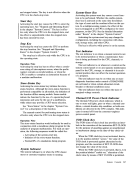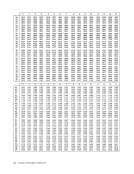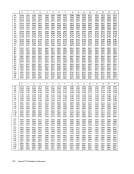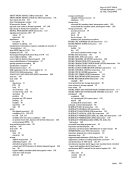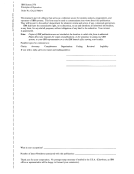Page ofGA22-7000-4 Revised September 1, 1975
By TNL: GN22-0498SRR UPDATE Routine
Initial conditions:
General register (GR) 2 contains the address of the word
to beupdated. L 3,0(2) FETCH THE WORD TRY AGN LR 4,3 MOVE IT TO GR4
[ANYINSTRUCTION] MODIFY GR4 (e.g., add a constant,
set a bit, etc.)CS BNE
3,4,0(2)STORE THE NEW VALUE IF THE WORD HAS NOT CHANGED
TRYAGN
The branch toTRY AGN is different from "bit-spinning" in that the branch will be taken only if some other program modifies the update location. If a number of CPUs simul
taneously attempt to modify one location, oneCPU will
fall through the loop, another will loop once, and so on until
allCPUs have succeeded.
BypassingPOST The following routine allows the SVC "POST" as used in OS/VS to be bypassed whenever the corresponding WAIT
has not yet been issued, provided that the supervisor WAIT
andPOST routines use COMPARE AND SWAP to manipu
late event control blocks(ECBs). BYPASS POST Routine
Initial conditions:
GRl contains the address of theECB. GRO contains the POST code. HSPOST L 3,0(1) GR3 = CONTENTS OF ECB
LTR 3,3 ECB MARKED 'WAITING'
BMPSVC YES, ISSUE AN SVC CS 3,0,0(1) NO, STORE POST CODE BE EXIT CONTINUE PSVC SVC POST ECB ADDRESS IS IN GRl, POST CODE IN GRO EXIT [ANY INSTRUCTION] A corresponding bypass WAIT function, using TM, is in
use at present.
The following routine may beused in place of the previous HSPOST routine if the ECB is assumed to contain zeros
when it is not"WAITING." HSPOST SR 0,0 CS 0,2,0(1) BE EXIT SVC POST EXIT [ANY INSTRUCTION] Lock/Unlock When SRRs larger than a doubleword are to be updated, it
is usually necessary to provide special interlocks to ensure
312System/370 Principles of Operation
that a single program at a time updates the SRR. In general,
updating a list, or even scanning a list, cannot be safely
accomplished without first"freezing" the list. However,
theCOMPARE AND SWAP instructions can be used in
certain restricted situations to perform queuing and list
manipulation.Of prime importance is the capability to per
form the lock/unlock functions and to provide sufficient
queuing to resolve contentions, either in aLIFO or FIFO manner. The lock/unlock functions can then be used as the
interlock mechanism for updating anSRR of any complexity.
The lock/unlock functions are based on the use of a header
associated with the SRR. The header is the common starting
point for determining the states of the SRR, either free or
in use, and is also used for queuing requests when con
tentions occur.Contentions are resolved using WAIT and POST. Although the examples do not show it, it is expected
that theBYPASS WAIT and BYPASS POST would be used.
The general programming technique requires that the pro
gram that encounters a lockedSRR must "leave a mark on
thewall" indicating the address of an ECB on which it will
WAIT. The program"unlocking" sees the mark and posts
theECB, thus permitting the waiting program to continue.
In the two examples given, all programs using a particularSRR must use either the LIFO queuing scheme or the FIFO scheme; the two cannot be mixed. When more complex
queuing is required, it is suggested that the queue for theSRR be locked using one of the two methods shown. Lock/Unlock with LIFO Queuing for Contentions
The header consists of a word, which can contain zero, a
positive value, or a negative value.• A zero value indicates that the SRR is free. • A negative value indicates that the SRR is in use but no
additional programs are waiting for the SRR.• A positive value indicates that the SRR is in use and that
one or more additional programs are waiting for the SRR.
Each waiting program is identified by an element in a
chained list. The positive value in the header is the address
of the element most recently added to the list.. Each element consists of two words. The first word is used
as anECB; the second word is used as a pointer to the next
element in the list. A negative value in a pointer indicates
that the element is the last element in the list. The element
is required only if the program finds theSRR locked and
desires to be placed in the list.
The following char
f. scribes the action taken for LIFO LOCK and LIFO UNLOCK routines.
By TNL: GN22-0498
Initial conditions:
General register (GR) 2 contains the address of the word
to be
[ANY
set a bit, etc.)
3,4,0(2)
TRYAGN
The branch to
taneously attempt to modify one location, one
fall through the loop, another will loop once, and so on until
all
Bypassing
has not yet been issued, provided that the supervisor WAIT
and
late event control blocks
Initial conditions:
GRl contains the address of the
LTR 3,3 ECB MARKED 'WAITING'
BM
use at present.
The following routine may be
when it is not
is usually necessary to provide special interlocks to ensure
312
that a single program at a time updates the SRR. In general,
updating a list, or even scanning a list, cannot be safely
accomplished without first
the
certain restricted situations to perform queuing and list
manipulation.
form the lock/unlock functions and to provide sufficient
queuing to resolve contentions, either in a
interlock mechanism for updating an
The lock/unlock functions are based on the use of a header
associated with the SRR. The header is the common starting
point for determining the states of the SRR, either free or
in use, and is also used for queuing requests when con
tentions occur.
that the
The general programming technique requires that the pro
gram that encounters a locked
the
WAIT. The program
the
In the two examples given, all programs using a particular
queuing is required, it is suggested that the queue for the
The header consists of a word, which can contain zero, a
positive value, or a negative value.
additional programs are waiting for the SRR.
one or more additional programs are waiting for the SRR.
Each waiting program is identified by an element in a
chained list. The positive value in the header is the address
of the element most recently added to the list.
as an
element in the list. A negative value in a pointer indicates
that the element is the last element in the list. The element
is required only if the program finds the
desires to be placed in the list.
The following char
f
























































































































































































































































